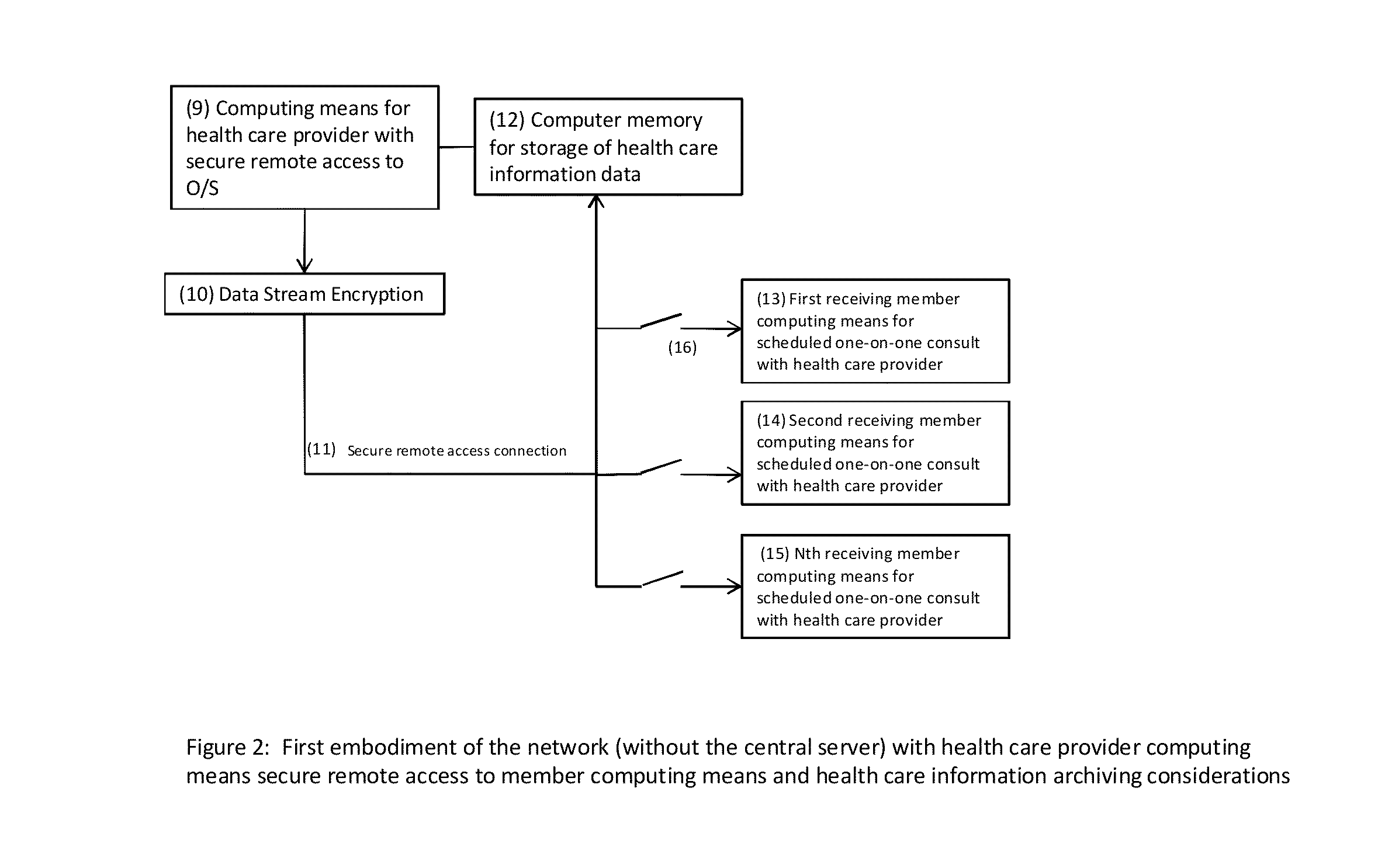Computer Network-Interfaced Method for Health Care Provider Active Reach Into Diverse Sub-Population Communities
- Summary
- Abstract
- Description
- Claims
- Application Information
AI Technical Summary
Benefits of technology
Problems solved by technology
Method used
Image
Examples
first embodiment
[0062]FIG. 2 illustrates the method in which the at-least one health care provider computing means (9) is linked, using secure remote access (11) software, to the at-least one sub-population community member computing means (13, 14, 15). The secure remote access (11) will be compatible depending on the operating system (O / S) of the two computing means linked at any given time in the method. There are commercial versions of secure remote access software that can be utilized for this step of the process or a custom secure remote access may be designed. The commercial versions include, but are not limited to: Windows Server 2008 NPS Routing and Remote Access VPN services, Windows Server 2008 Terminal Services Gateway, Microsoft ISA 2006 and Forefront Threat Management Gateway (TMG), Intelligent Application Gateway 2007 and Unified Access Gateway (UAG), or Network Connect for Mac. Virtual desktop applications may also be used for secure remote access. The data stream (10) between the he...
third embodiment
[0065]FIG. 4 illustrates the method to show an example of how the method might be used for the scenario of combined mental health and public health provider interactions with a particular sub-population community. In this embodiment, the provider computing means (9) belongs to a MH provider or PH provider, who utilizes the method's secure remote access connection (11) to the network-interfaced member computing means (18). In this embodiment, the MH or PH provider computing means (9) can communicate with the member's computing means (18) for the purpose of guiding the production of a life-episode data according to a protocol (33) downloaded from the method's web-site graphic user interface (GUI) as described later in FIG. 6 and FIG. 8. Using the secure remote access connection (11), the MH or PH provider may take control of the member computing means, if necessary to overcome a technical skill challenge due to a member's lack of computing skills to produce said life-episode audio-vid...
fourth embodiment
[0067]the method is shown in FIG. 5. This embodiment is identical to the embodiment of FIG. 4 except that the storage of the life-episode audio-video data stream includes the step of storing on a central server computing means memory (17), as opposed to the provider computing means memory, without loss of efficacy for the method.
[0068]FIG. 6 illustrates key features of the method's network-interface web software for sub-population community members. The registration step (22) of the method was covered in detail in the illustration of FIG. 1. The other key features of the web software for the method will now be provided. A life-episode protocol list and GUI for downloading a particular protocol is shown in (23). FIG. 8 will provide more detailed description of the protocols for the method. Members will utilize their network-interfaced computing means and secure logon information (username and password) to access the method's GUI (23) and select a protocol for a life-episode productio...
PUM
 Login to View More
Login to View More Abstract
Description
Claims
Application Information
 Login to View More
Login to View More - R&D
- Intellectual Property
- Life Sciences
- Materials
- Tech Scout
- Unparalleled Data Quality
- Higher Quality Content
- 60% Fewer Hallucinations
Browse by: Latest US Patents, China's latest patents, Technical Efficacy Thesaurus, Application Domain, Technology Topic, Popular Technical Reports.
© 2025 PatSnap. All rights reserved.Legal|Privacy policy|Modern Slavery Act Transparency Statement|Sitemap|About US| Contact US: help@patsnap.com



